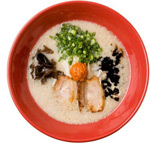Restaurant
IPPUDO
Address:
65 Fourth Avenue (Between 9th and 10th Street)
New York, NY 10003
Phone: 212-388-0088
Website: www.ippudony.com
Pricing: $$
Description:
IPPUDO is all over Japan. Shigemi Kawahara, the Ramen King, directs and oversees this well known entity. His guidance and leadership elevated the level of ramen to the realm of art. There are now 43 shops throughout Japan, from Fukuoka (the base and starting point) to Tokyo, Osaka and other cities. IPPUDO satisfies twenty thousand customers a day to meet their demand for his special ramen. The shop in New York is the very first for Shigemi Kawahara to make his long-awaited overseas debut. Under the banner "Keep changing to remain unchanged", the IPPUDO team, tapping the potential for ramen, will spread the ´Japanese ramen culture´ from New York to the rest of the world.The Revolutionary Team Constantly Seeks ChangesOn October 15, 1985, IPPUDO was opened with a counter seating capacity of 10. Shigemi Kawahara the Ramen King made a grand impact on the industry with his original interior design and Tonkotsu (pork based) ramen. The classy shop interior with his heavy emphasis on wood is like a wood sculptor´s studio yet kept sparkling clean with modern jazz playing in the background. The attention to detail and hospitable service translate to quality dining in a modest establishment with a décor and ambiance that hints at sophistication and quality.Tonkotsu ramen soup is free of the usual smell of pork with a light aftertaste. The selection of ingredients and the seasoning suited to the customer´s well-being has won over female customers tempting them to want to try it everyday. Thanks to the efforts, discipline and quality standards of the Ramen King, the status of ramen has been raised to become one of Japan´s most favored dishes by young and old alike.Yet, IPPUDO does not just stand on its laurels. As a revolutionary flag bearer, the team exhaustively explores the possibilities of ramen. This resulted in ground-breaking innovations being added to Tonkotsu ramen and eventually impressed people from overseas, not to mention the Japanese. In the meantime, the team scrutinizes ingredients and seasonings from around the world to successively create new ramen varieties using some of the various cooking techniques found worldwide. Twenty years since its establishment, IPPUDO continues to impact the ramen industry. The fast food that was originally a JPY500-bowl is now a complete meal costing JPY1,000. To introduce one of Japan´s national dishes to the world culture, IPPUDO initiated its ambitious efforts toward an auspicious future in New York.Ramen is a Microcosmos in a BowlRamen is a cosmos created in a bowl. The basic broth is derived from the essence of pork, chicken, beef, or seafood, and seasoned with soy sauce, salt, miso, and other important ingredients. It´s totally up to each individual chef to decide which ingredients and how much to use. Flour, eggs, kansui (an alkaline water) and other ingredients are used to make noodles. The chefs do not simply mix these ingredients together. Their own particular originality is infused into the thickness, length, form, and texture of noodles. Toppings such as yakibuta (roast pork) and ni-tamago (soy sauce flavored boild egg) are also selectively used according to the tastes, preference and individuality of the chef. Soup, noodles, and topping – the trinity brings forth the cosmos. Ramen is quite a creative dish with infinite potential for expansion and diversity.Ramen is Japan´s Soul FoodJapanese ramen has a roughly 400-year history. At the beginning of the 20th century, expatriate Japanese from mainland China sold ramen at food stalls in Yokohama´s Chinatown. This is how ramen spread to the rest of Japan. In those days, Chinese lamian (pulled noodles) was adapted to suit Japanese preferences and called Chuka Soba (Chinese noodles). A simple bowl of Chuka Soba, egg noodles in a broth made from chicken stock seasoned with soy sauce, became popular for its taste, reasonable price, and fast service.In the 1950s, Chuka Soba gradually proliferated to become the common people´s taste readily enjoyed by one and all. In the meantime, ramen made its emergence through the cooking techniques used for Chuka Soba. Then it was only a matter of time until the ramen varieties flourished locally and regionally using available traditional ingredients.In the 1980s, many chefs and cooks became enchanted by the freedom and depth that ramen offered, and ramen shops started popping up one after another. These chefs stimulated, motivated and encouraged one another, to advance the rise in the Japanese ramen market.Now, one bowl of ramen has that special something that transcends all culinary ethnicities and nationalities such as Japanese, Chinese, French, Italian, and Indian. Although there are thousands of different flavors and varieties, they are all known by the collective name "ramen." Thus this Japanese soul food, ramen, was born out of each chef´s individual and free, unconstrained idea and concept.
Posted By: Chief Foodie Officer
Comments:
|
| Ok, I have to admit that when my daughter told me she was taking me to a ramen noodle restaurant I had visions of the plastic wrapped instant soups that we ate in college when we couldn´t afford real food. I really tried to talk her out of it, but she was insistent that I would love this place and I have learned long ago to trust her foodie recommendations. In spite of that, I could have never expected the amazing culinary experience that we were about to have. Saturday - April 6, 2013 |











